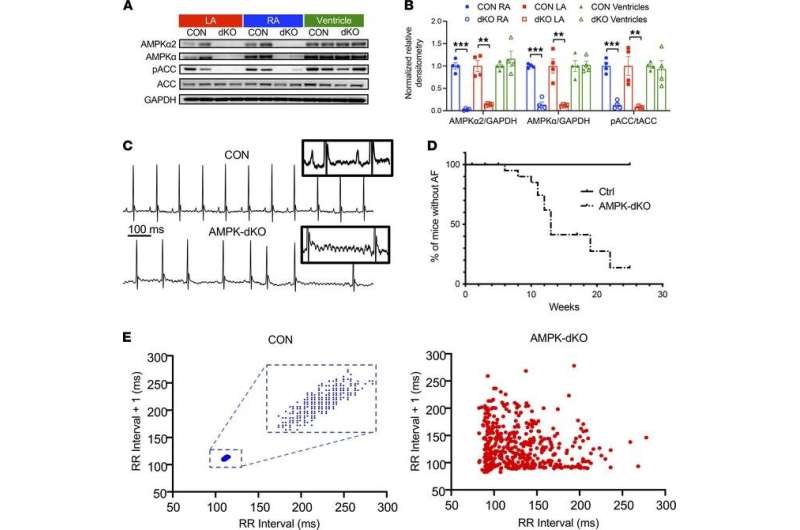Atrium-selective deletion of AMPK leads to atrial fibrillation in mice. AMPK expression and the development of atrial fibrillation in AMPK double-KO sarcolipin-Cre Prkaa1fl/fl Prkaa2fl/fl (AMPK-dKO) compared with littermate control Prkaa1fl/fl Prkaa2fl/fl (CON) mice. (A) Representative immunoblots with antibodies recognizing the AMPK α2 subunit, both α1 and α2 AMPK subunits (AMPKα), the downstream AMPK target acetyl-CoA carboxylase (ACC), and the phosphorylated form of ACC (pACC) in the left atria (LA), right atria (RA), and left ventricle. (B) Corresponding densitometric quantification of the immunoreactive bands. Values are mean ± SEM of n = 6–8 per group. **P < 0.01, ***P < 0.001 versus CON by unpaired Student’s t test. (C) Representative in vivo ECG (lead II) tracings showing normal sinus rhythm in a CON and atrial fibrillation in an atrial AMPK-dKO mouse at 6 weeks of age. Insets show magnified views that demonstrate highly organized atrial P-wave electrical activity in CON and course fibrillatory waves in AMPK-dKO mice. Scale bars: 100 ms. (D) Kaplan-Meier analysis showing the 6-month event-free survival from atrial fibrillation in CON (n = 18) versus AMPK-dKO mice (n = 23), P < 0.001. (E) Graphs show heart rate variability in representative examples of CON mice in sinus rhythm and AMPK-dKO mice in atrial fibrillation, comparing sequential R-R intervals during 60-second recordings (n = 533 intervals for CON and n = 454 intervals for AMPK-dKO mice). Credit: JCI Insight (2022). DOI: 10.1172/jci.insight.141213
Research from the Yale School of Medicine indicates that a protein kinase that is a master regulator of cell metabolism is critical to preventing atrial fibrillation. The research appeared April 22 in the journal JCI Insight.
Lawrence H. Young, MD, professor of medicine and cellular and molecular physiology, and senior author of the study, said that the link between metabolic stress and atrial fibrillation is not well-understood.
"We need to understand the mechanisms linking metabolic disease and the genesis of atrial fibrillation," said Young. "Our aim was to define the role of AMPK in preventing atrial molecular, electrophysiological, and structural remodeling."
The research team used genetically altered mice to explore the biological effects of the enzyme AMP-activated protein kinase (AMPK) in the atria, the upper chambers of the heart. AMPK is essential to maintaining metabolic function in the heart and other organs. In collaboration with Fadi G. Akar, Ph.D., an associate professor who co-authored the study, the Young lab demonstrated the adverse impact of genetic deletion of AMPK on atrial molecular, electrical, and structural remodeling culminating in persistent atrial fibrillation.
The authors also found that Pitx2c and Mef2c—transcription factors that are essential in cardiac development—are affected by AMPK deletion and are critical in maintaining normal atrial molecular programing.
While additional research is needed, the findings suggest that reduced AMPK activity that occurs in elderly patients with metabolic disease, such as diabetes and obesity, might contribute to atrial enlargement and the development of electrical dysfunction. The discovery could lead to potential therapies for atrial fibrillation that address the underlying cause of the disease.
Atrial fibrillation is the most common arrhythmia, or heart rhythm disturbance. The incidence of atrial fibrillation is rising, and these arrhythmias are known to cause blood clots, stroke, heart failure, and other cardiovascular complications.
More information: Kevin N. Su et al, Atrial AMP-activated protein kinase is critical for prevention of dysregulation of electrical excitability and atrial fibrillation, JCI Insight (2022). DOI: 10.1172/jci.insight.141213
Provided by Yale University























